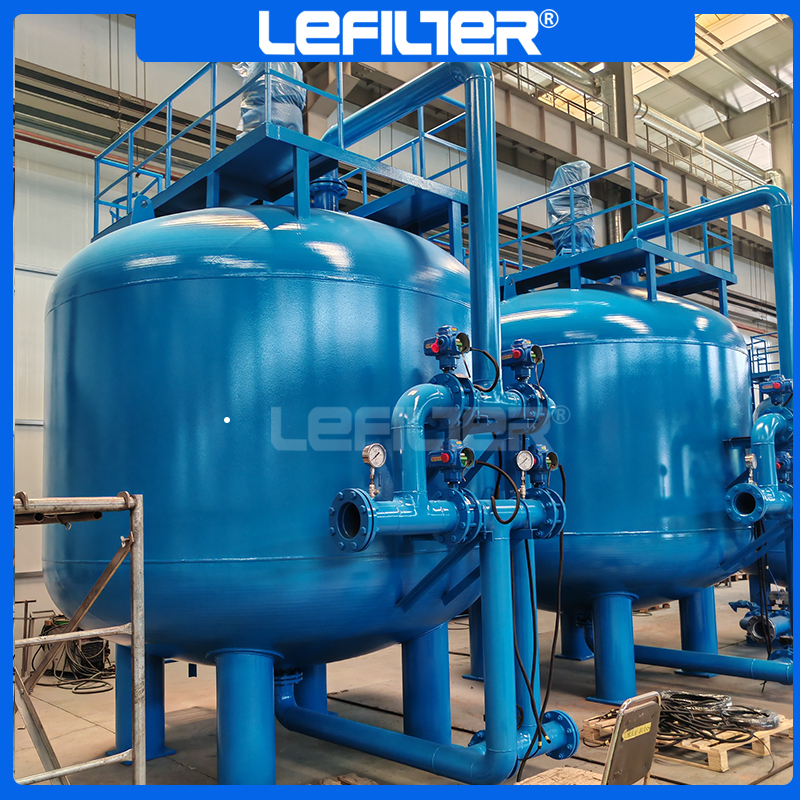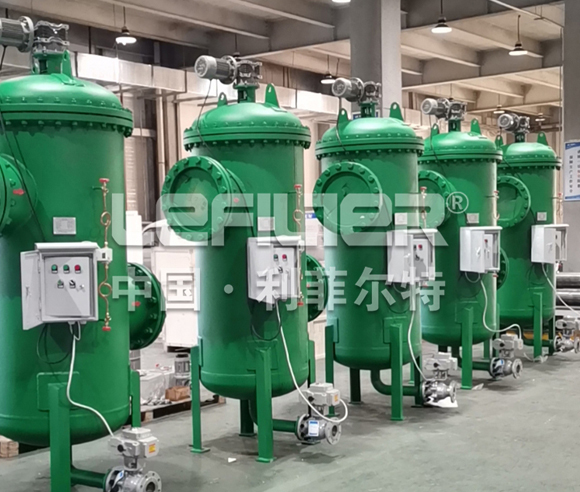Case Study: High-Efficiency Filters in Nuclear Power Plants
DATE:2024-12-07 Number of views: 1 Source:dongwenhui
Nuclear power plants are some of the most complex and high-risk facilities in the world. They require the highest levels of operational safety, efficiency, and reliability, due to the potential hazards associated with radiation, heat generation, and environmental impact. A critical aspect of maintaining safety and operational efficiency in nuclear plants is managing the cooling water systems, which ensure that the reactors remain within safe temperature limits. In this context, high-efficiency filters play a crucial role by improving water quality, preventing system failures, and supporting long-term sustainability.
We have several case studies where high-efficiency filters have been successfully implemented in nuclear power plants, leading to improvements in cooling water systems, and ultimately, safer and more efficient operations.
The Role of Cooling Water Systems in Nuclear Plants
In nuclear power plants, cooling systems are essential for regulating the temperature of the reactor and other plant equipment. These systems rely heavily on water, typically sourced from nearby lakes, rivers, or oceans, to dissipate the heat generated by the reactor. The water is pumped through various cooling circuits to absorb the heat and then returned to the source.
However, this water often contains suspended particles, algae, debris, and other contaminants, which can clog the cooling system, reduce its efficiency, and potentially damage critical equipment. As the efficiency of the cooling system is directly linked to the overall safety and operation of the plant, maintaining high-quality water is a key priority. This is where high-efficiency filters come into play, helping to ensure that the cooling systems function optimally and safely.
Case Study 1: High-Efficiency Filtration for Cooling Water in U.S. Nuclear Plant
In a nuclear power plant in the United States, a comprehensive upgrade was made to the cooling water system, specifically targeting the filtration process. The plant faced recurring issues with algae, organic matter, and suspended solids clogging the heat exchangers, which led to reduced heat transfer efficiency and increased maintenance costs. The plant management decided to install a high-efficiency filtration system to address these challenges.
Solution:
The plant adopted a multi-stage filtration approach using high-efficiency cartridge filters, membrane filtration, and automatic self-cleaning filters. These filters were capable of removing fine particles and organic matter, significantly reducing the amount of suspended solids in the cooling water. The system was designed to handle large volumes of water while ensuring that only clean, filtered water entered the cooling circuit.
Results:
After the installation of the high-efficiency filters, the plant saw a marked improvement in the efficiency of the cooling water system. The filters successfully removed nearly 99% of suspended solids, which significantly reduced the risk of clogging in heat exchangers and other critical equipment. As a result, the plant experienced fewer system failures, reduced maintenance downtime, and improved overall heat transfer efficiency. The plant's operational costs also decreased due to reduced cleaning and replacement of damaged components.

Case Study 2: High-Efficiency Filters in European Nuclear Power Facility
In another European nuclear facility, operators were dealing with high turbidity levels in the cooling water sourced from a nearby river. This caused frequent blockages in the condenser tubes and a significant reduction in the heat exchange rate, leading to inefficiencies and potential safety concerns. The plant's management team decided to implement high-efficiency filtration technology to enhance the reliability and performance of the cooling system.
Solution:
The facility opted for a combination of sand filters, activated carbon filters, and fine mesh filters that were designed to capture and remove both large and fine particulate matter from the water. The activated carbon filters were particularly effective in removing organic contaminants and chlorine, which are known to damage metal components in the cooling system.
Results:
After the installation of the high-efficiency filters, the plant experienced a significant reduction in turbidity levels, and the cooling water quality was vastly improved. The rate of clogging in the condenser tubes dropped sharply, and the efficiency of heat transfer improved. Not only did this lead to better operational efficiency, but it also extended the lifespan of critical components, reducing maintenance needs and preventing costly repairs. Moreover, the plant was able to meet regulatory standards for water discharge, ensuring that their environmental compliance was maintained.

Case Study 3: Filtration Upgrade in Japanese Nuclear Power Plant
A nuclear power plant in Japan was facing challenges related to biofouling in its cooling water system. Biofouling, the accumulation of microorganisms such as bacteria and algae, was causing blockages and corrosion in the plant's cooling water pipes and heat exchangers. These issues led to a decrease in heat exchange efficiency, increased energy consumption, and a higher risk of equipment failure.
Solution:
The plant implemented a high-efficiency filtration system consisting of both mechanical filters and biological filtration technologies. The mechanical filters were designed to capture large particles, while the biological filtration systems, including ultraviolet (UV) disinfection units, were used to eliminate microorganisms and prevent biofouling. The UV disinfection system was particularly effective in reducing the growth of harmful microorganisms in the cooling water system.
Results:
The new filtration system led to a significant reduction in biofouling, resulting in fewer blockages and lower corrosion rates in the cooling system. This improved the heat exchange efficiency, reducing energy consumption and ensuring that the plant operated at optimal levels. Additionally, the plant was able to extend the lifespan of critical cooling components, resulting in long-term cost savings.

Case Study 4: Cooling Water Filtration in Nuclear Power Plant in the UK
A nuclear power plant in the UK faced an issue with the buildup of fine sediment and sand in its cooling water system, which was affecting the efficiency of its heat exchangers. This situation was exacerbated by the plant's location near the coast, where sand and sediment are easily carried by ocean currents.
Solution:
To tackle this problem, the plant installed a high-efficiency sand filtration system, which used multi-layered filters to capture sediment and sand particles from the incoming cooling water. The filters were capable of removing particles as small as 5 microns, significantly improving the quality of the water entering the cooling system.
Results:
The installation of the sand filtration system resulted in a dramatic improvement in the cooling water quality. The removal of sediment and sand particles reduced the wear and tear on heat exchangers and other components of the cooling system, leading to improved heat transfer and lower energy consumption. Additionally, the system reduced the frequency of maintenance interventions and extended the operational life of the cooling equipment.

Conclusion
High-efficiency filtration technologies have proven to be a critical component in improving the safety, reliability, and efficiency of cooling water systems in nuclear power plants. The case studies discussed demonstrate how these filtration systems help address various water quality issues, including turbidity, biofouling, and sediment buildup. By enhancing the quality of the cooling water, these systems not only improve the performance of heat exchangers and other critical components but also reduce maintenance costs, prevent system failures, and ensure compliance with environmental and safety regulations.
The successful implementation of high-efficiency filters in nuclear plants highlights the importance of investing in advanced filtration technologies to ensure the long-term sustainability and safety of nuclear energy operations. As nuclear plants continue to play a vital role in the global energy landscape, maintaining high water quality will remain an essential aspect of plant management.
FAQ
What are high-efficiency filters used for in nuclear power plants?
High-efficiency filters are used to remove contaminants such as suspended solids, algae, and biofouling organisms from cooling water systems, ensuring the safe and efficient operation of nuclear plants.
What types of filters are commonly used in nuclear power plants?
Common filters include cartridge filters, sand filters, activated carbon filters, and biological filtration systems, each targeting specific contaminants in the cooling water.Why is cooling water filtration important in nuclear plants?
Cooling water filtration is crucial to prevent the clogging of equipment, reduce corrosion, improve heat transfer efficiency, and ensure environmental compliance.How does biofouling affect cooling systems in nuclear power plants?
Biofouling, the accumulation of microorganisms in cooling water, can cause blockages, corrosion, and inefficiencies in heat exchangers, increasing maintenance costs and risk of equipment failure.
How do sand filters improve cooling water quality in nuclear plants?
Sand filters remove fine particles, sediment, and debris from cooling water, preventing them from clogging cooling system components and improving heat transfer efficiency.What is the role of UV disinfection in cooling water systems?
UV disinfection eliminates harmful microorganisms, preventing biofouling and ensuring the safe operation of cooling systems in nuclear plants.Can high-efficiency filters reduce maintenance costs?
Yes, by preventing system blockages and reducing wear and tear on components, high-efficiency filters help lower maintenance costs and extend the lifespan of equipment.How do high-efficiency filters ensure environmental compliance in nuclear plants?
By improving the quality of discharged water, high-efficiency filters help nuclear plants meet environmental regulations related to water quality and emissions.


